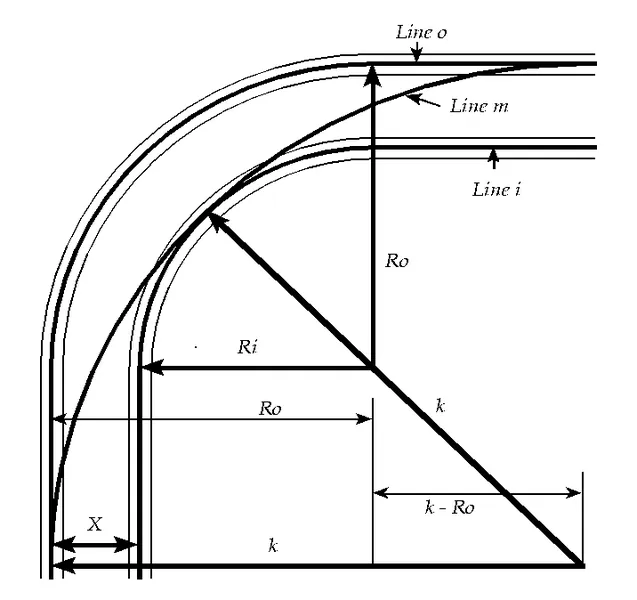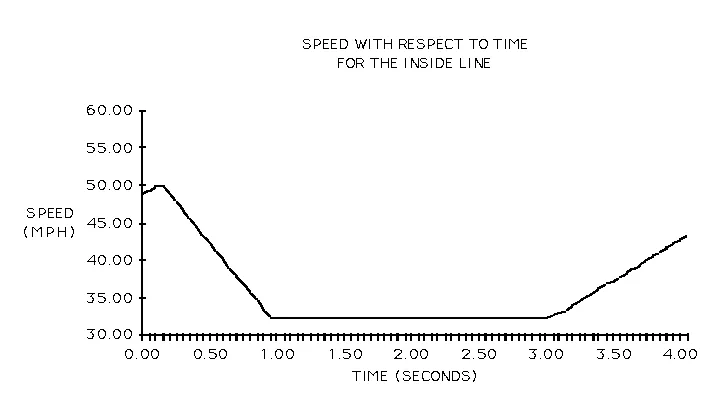No Bucks Racing Club
P.O. Box 662
Burbank, CA 91503
(C)Copyright 1991
This month, we analyze the best way to go through a corner. "Best" means in the least time, at the greatest average speed. We ask "what is the shape of the driving line through the corner that gives the best time?" and "what are the times for some other lines, say hugging the outside or the inside of the corner?" Given the answers to these questions, we go on to ask "what shape does a corner have to be before the driving line I choose doesn't make any time difference?" The answer is a little surprising.
The analysis presented here is the simplest I could come up with, and yet is still quite complicated. My calculations went through about thirty steps before I got the answer. Don't worry, I won't drag you through the mathematics; I just sketch out the analysis, trying to focus on the basic principles. Anyone who would read through thirty formulas would probably just as soon derive them for him or herself.
There are several simplifying assumptions I make to get through the analysis. First of all, I consider the corner in isolation; as an abstract entity lifted out of the rest of a course. The actual best driving line through a corner depends on what comes before it and after it. You usually want to optimize exit speed if the corner leads onto a straight. You might not apex if another corner is coming up. You may be forced into an unfavorable entrance by a prior curve or slalom.
Speaking of road courses, you will hear drivers say things like "you have to do such-and-such in turn six to be on line for turn ten and the front straight." In other words, actions in any one spot carry consequences pretty much all the way around. The ultimate drivers figure out the line for the entire course and drive it as a unit, taking a Zen-like approach. When learning, it is probably best to start out optimizing each kind of corner in isolation, then work up to combinations of two corners, three corners, and so on. In my own driving, there are certain kinds of three corner combinations I know, but mostly I work in twos. I have a long way to go.
It is not feasible to analyze an actual course in an exact, mathematical way. In other words, although science can provide general principles and hints, finding the line is, in practice, an art. For me, it is one of the most fun parts of racing.
Other simplifying assumptions I make are that the car can either accelerate, brake, or corner at constant speed, with abrupt transitions between behaviors. Thus, the lines I analyze are splices of accelerating, braking, and cornering phases. A real car can, must, and should do these things in combination and with smooth transitions between phases. It is, in fact, possible to do an exact, mathematical analysis with a more realistic car that transitions smoothly, but it is much more difficult than the splice-type analysis and does not provide enough more quantitative insight to justify its extra complexity for this article.
Our corner is the following ninety-degree right-hander:

This figure actually represents a family of corners with any constant width, any radius, and short straights before and after. First, we go through the entire analysis with a particular corner of 75 foot radius and 30 foot width, then we end up with times for corners of various radii and widths.
Let us define the following parameters:
Now, when we drive this corner, we must keep the tires on the course, otherwise we get a lot of cone penalties (or go into the weeds). It is easiest (though not so realistic) to do the analysis considering the path of the center of gravity of the car rather than the paths of each wheel. So, we define an effective course, narrower than the real course, down which we may drive the center of the car.
This course is indicated by the labels and the thick radius lines in the figure.
From last month's article, we know that for a fixed centripetal acceleration, the maximum driving speed increases as the square root of the radius. So, if we drive the largest possible circle through the effective corner, starting at the outside of the entrance straight, going all the way to the inside in the middle of the corner (the apex), and ending up at the outside of the exit straight, we can corner at the maximum speed. Such a line is shown in the figure as the thick circle labeled "line
One might argue that there are certain advantages of line
If we assume a maximum centripetal acceleration of 1.10g, which is just within the capability of autocross tires, we get the following speeds for the cornering phases of Lines

Line
For line

Because we can begin by accelerating, we start beating line
What if the corner were tighter or of greater radius? The following table shows some times for 30 foot wide corners of various radii:

Line
How about for various widths? The following table shows times for a 75 foot radius corner of several widths:

The wider the course, the greater the margin of loss. This is, again, intuitive since on a wide course, line
So, the answer is, under the assumptions made, that the inside line is never better than the classic racing line. For the splice-type car behavior assumed, I conjecture that no line is faster than line
We have gone through a simplified kind of variational analysis. Variational analysis is used in all branches of physics, especially mechanics and optics. It is possible, in fact, to express all theories of physics, even the most arcane, in variational form, and many physicists find this form very appealing. It is also possible to use variational analysis to write a computer program that finds an approximately perfect line through a complete, realistic course.
[hr]
converted by: rck@home.net
Thu Sep 29 14:05:26 PDT 1994



